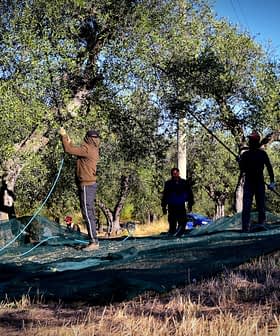Coating Food Prep Surfaces With Cooking Oil May Prevent Cross-Contamination
According to one researcher, the new discovery could have numerous applications that make food processing and preparation safer and more cost-efficient.
Research published in the American Chemical Society’s Journal of Applied Materials and Interfaces suggests that applying a thin layer of cooking oil to stainless steel surfaces can deter bacteria growth by filling in microscopic cracks and fissures. Ben Hatton, a professor at the University of Toronto, led the study and found that coating stainless steel surfaces with a food-safe chemical and cooking oil creates a hydrophobic layer that acts as a barrier to contamination, potentially revolutionizing food processing equipment cleaning procedures.
Applying a thin layer of cooking oil, such as olive oil, to stainless steel food processing implements may deter the growth of bacteria, according to new research published in the American Chemical Society’s Journal of Applied Materials and Interfaces.
The cooking oil does so by filling in microscopic fissures and cracks on the vessel’s surface that otherwise may be contaminated by bacteria and leftover food residue.
Coating a stainless steel surface with an everyday cooking oil has proven remarkably effective in repelling bacteria.
“Coating a stainless steel surface with an everyday cooking oil has proven remarkably effective in repelling bacteria,” Ben Hatton, one of the paper’s authors and professor at the University of Toronto, said.
“The oil fills in the cracks, creates a hydrophobic layer and acts as a barrier to contamination on the surface.”
Hatton told Olive Oil Times that the research began when Agri-Neo, a Canadian seed producing company, approached him and inquired about how to prevent cross-contamination in their seed-processing equipment.
“So they were describing this problem of contamination. Bacteria sticking to the stainless steel surface that was used for mixing,” he said. “They always had to clean it off and make sure there was no more bacterial contamination, so we decided to try to apply this idea from Harvard.”
Hatton had previously worked on how to make surfaces slippery and non-adhesive at Harvard University by trapping liquid lubricant on a solid surface, However, he had never specifically focussed on doing this for food processing surfaces.
“What we did here was focus on lubricant liquids that are food safe because you need something that can mix with the food and is not going to be toxic or change the qualities in the food,” he said.
“We also needed to be super cheap because obviously, it’s an industry that has to keep costs down, so that’s why we focussed on cooking oils. Because obviously, it’s food safe and inexpensive. And olive oil certainly fits into that category.”
The process works by first coating the surface with a food-safe chemical called alkyl phosphate. When mixed with cooking oils, it forms an oily chain along the surface of the metal.
“That chemical helps to trap the oil in a really thin layer,” Hatton said. “If you don’t have it then the oil just kind of rolls off.”
The oily chain forms a microfilm that covers the microscopic cracks and fissures in the stainless steel, which are very difficult to clean without the use of harsh and astringent chemicals and is often where bacteria grows.
Due to how thin the layer of oil needs to be, only about a capful is required, which makes the process very cost efficient.
“It’s not much because the amount of oil we’re talking about is really thin,” Hatton said. “When we first put the oil on, it’s probably in the range of about 50 micrometers thick, about the same thickness as a piece of paper.”
A large part of the research focussed on what happened to this oily chain once the stainless steel surface had been cleaned. The researchers found that even though most of the oil was wiped away, some of it remained to block the scratches and fissures.
“Even though you wipe away most of the oil [when cleaning the surface], there’s a little bit that gets stuck in those grooves and scratches,” Hatton said. “And that is the most important part actually because that residual oil blocks those sites from bacteria and food getting in there.”
Hatton said that so far this research is only in the first stages and he hopes to partner with members of the cooking oil industry to both investigate his hypothesis further as well as see whether there is any difference among the various cooking oils.
However, he already believes that there are numerous applications for this research within the food industry, including the prevention of cross-contamination in large food packaging plants and industrial kitchens.
“I think what’s different about our work is that it is super simple. We are not changing the steel surface really, we’re adding that one molecule to the surface, but that’s the only change we’re making,” Hatton said. “I think that type of thinking can work for other things in the food industry, absolutely, food packaging.”
“Keeping bacteria from sticking to the surface is really key,” he added. “Killing bacteria is one way to do it, but if you can stop them from sticking that’s actually just as important.”









